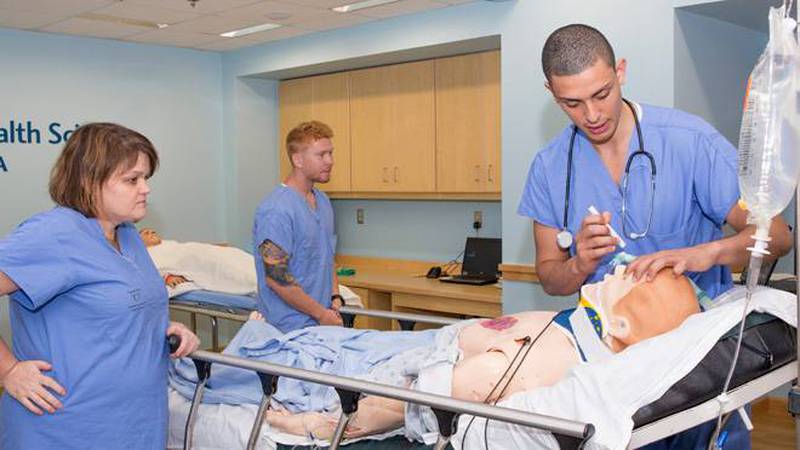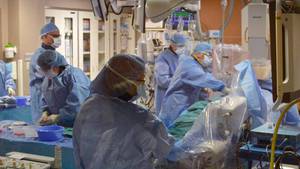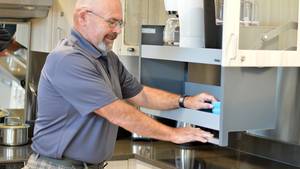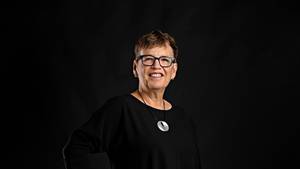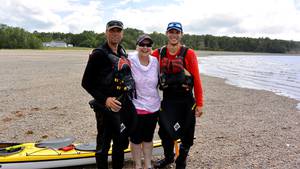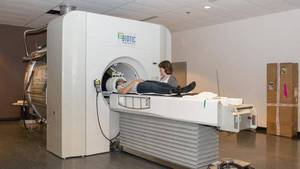A 65 year-old man has been found unconscious at the bottom of the stairs in his home. You’re a neurosurgery resident at the QEII’s emergency department where the man has since been rushed by ambulance. You’re at the patient’s bedside now. You’ve just learned from the attending nurse the man may have suffered a brain injury as a result of his fall. His condition is critical and deteriorating. Your neurosurgery colleague has just been called away.
The nurse turns to you and says, “what do you want to do, doc?”
The above can be a typical situation in neurosurgery and one of several simulated learning scenarios experienced by medical residents at a recent neurosurgery rookie camp held at the QEII Health Sciences Centre.
The first of its kind in Canada, the three-day program at the QEII’s Skills Centre for Health Sciences was designed to provide participants — neurosurgery residents at the beginning of their six-year training program — with a unique opportunity to experience typical patient situations in a simulated environment. Now in its second year, the rookie camp teaches the technical as well as cognitive and behaviour skills needed in neurosurgery, a field that often involves high-stakes, life-and-death situations; where efficient decision making is crucial.
This year’s camp was attended by 20 neurosurgery residents as well as students and faculty, providing representation from all of Canada’s neurosurgery training programs. In addition to practicing with neurosurgical tools and instruments, the residents were exposed to simulated scenarios where, in a safe, learning environment, they were put in high-stress situations that require grace under pressure.
The residents are aided by a broad spectrum of tools, ranging from sophisticated neurosurgery equipment, such as high-tech imaging and virtual reality machines, to low-fidelity instructional tools such as grapefruit — which mimics the tissues of the human brain. Each participant was able to practice many of the typical things that neurosurgeons do, including suturing brain tissue, drilling holes in a human skull and putting bones back together.
This year, the rookie camp introduced residents to the NeuroTouch surgical simulator which has recently been acquired through the generous support of the QEII Foundation. This simulator uses the most advanced medical simulation technology available anywhere in the world.
The residents also had the unique opportunity to practice their skills using human cadavers, the remains of people who have donated their bodies to science.
The program’s director, Dr. David Clarke, says the training camp is an attempt to help the rookie surgeons make the transition from medical school to residency. Dr. Clarke, who is Interim Head of Neurosurgery at Dalhousie and the QEII, says the camp focuses on the challenging hands-on elements of neurosurgery as well as the necessary communication and people skills needed on the job.
“They learn the technical skills, such as how to use bipolar forceps to stop bleeding, but we’re also trying to teach them how to collaborate with one another as part of a team,” says Dr. Clarke.
The course puts the residents in situations that have an emotional context, he says, with lots of distractions that produce occupational stress, and it gives them a framework to help them cope.
“We’re looking to see if they can demonstrate leadership,” he says. “We’re looking to see if they can interact with the health-care team and interact with patients and patients’ families.”
Dr. Clarke developed the program at the QEII last year after seeing something similar by colleagues in the U.S. He says it gives residents an early opportunity to encounter patient situations that, under normal circumstances, they may not get to experience until much later on in their career.
“We’ve come to discover that simply learning on the job is not good enough,” says Dr. Clarke. “From the perspective of patient care and patient safety, this program is highly valuable because it allows the residents to accumulate experiences and draw from situations that otherwise could take years for them to encounter.”
QEII innovation
Dr. Clarke developed the rookie camp at the QEII with the support of the Neurosurgery Specialty Committee of the Royal College of Physicians and Surgeons of Canada. The program is uniquely Canadian and represents the first time, for any surgical specialty, where all the doctors who are beginning their residency training have been brought together with teachers from across the country in a learning-intensive environment to better equip them for their chosen career. Local faculty members include Drs. Sean Christie, Simon Walling, Marie Matte, David Brandman and Greg Jenkins.
Dr. Clarke says the QEII is a national leader for developing such a program and the community should be very proud of that. It also exposes upcoming residents to everything the QEII has to offer.
“The feedback we’ve received has been tremendous and we’re delighted,” says Dr. Clarke. “We’re trying very hard to improve patient care and we’ll continue to do so. That’s what we’re all about.”
The next generation
Anton Fomenko, a medical resident in Winnipeg, was one of the residents who attended the rookie camp. He says he was expecting more of an academic program and was pleasantly surprised by its hands-on, highly interactive approach. Getting the experience of opening up a human brain cadaver, he says, was invaluable to him as a surgeon at the beginning of his residency.
He adds that meeting the other residents, learning from the senior physicians, and using the state-of-the-art neurosurgery tools were also highlights.
“It gave me a real boost to see all the many things that can be done in this field,” he says. “That’s very exciting.”
Medical resident Michelle Kameda agrees. The Brampton, Ont. native was similarly impressed with the various technologies on hand at the QEII, such as the suturing tools, as well as the level of expertise.
“I found all the instructors very approachable,” she says. “Starting out in this field can be quite scary and it was great to get feedback from the people who have the experience.”

